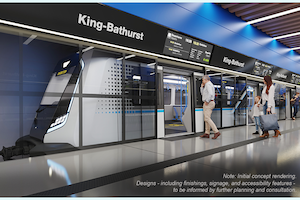Ontario Line RSSOM contract awarded, RFQs issued for work on north component
The Ontario government has taken two major steps toward starting construction on its Ontario Line subway project.
 Transportation Minister Caroline Mulroney announced on November 17 that the province had awarded a major contract for the Ontario Line Rolling Stock, Systems, Operations and Maintenance (RSSOM) contract and had issued a request for qualifications for work on the northern segment of the line.
Transportation Minister Caroline Mulroney announced on November 17 that the province had awarded a major contract for the Ontario Line Rolling Stock, Systems, Operations and Maintenance (RSSOM) contract and had issued a request for qualifications for work on the northern segment of the line.
“These milestones bring us one step closer to delivering a world-class transit system for the GTA,” Mulroney said. “Our government continues to work at an unprecedented pace to move the Ontario Line forward, alleviating gridlock on our roads and creating thousands of good local jobs.”
The RSSOM contract, worth $9 billion, was awarded to the Connect 6ix consortium. The scope of work sees the companies commit to a 30-year design, build, finance, operate and maintain arrangement.
Connect 6ix is led jointly by Plenary Americas, Hitachi Rail, Webuild Group (Salini Impreglio Canada Holding Inc.), and Transdev Canada Inc. Design support is being provided by Hitachi Rail and IBI Group Professional Services, with construction being performed by Hitachi Rail, Webuild Group (Astaldi Canada Design & Construction Inc. and Salini Impreglio Civil Works Inc.), and NGE Contracting Inc.
The team will begin mobilizing their design and construction crews, with work to commence in 2023. The project is anticipated to be completed in 2031.
The consortium anticipates that its work on the RSSOM contract will support an estimated 800 jobs, the majority of which will come from the Greater Toronto Area.
Meanwhile, Infrastructure Ontario and Metrolinx have issued two requests for qualifications for major works along the North segment of the line.
The RFQs are for the following contracts:
Pape Tunnel and Underground Stations – Progressive Design-Build contract
- Three kilometres of twin tunnels underneath Pape Avenue between the Gerrard portal and the Don Valley bridge
- Underpinning of the existing TTC Pape Station on Line 2.
- Two underground stations (Pape and Cosburn) and two portals
- Three emergency exit buildings/emergency services buildings
- A rail switch/crossover in the section of tunnel near Sammon Avenue
- Interface with Line 2 TTC subway
Elevated Guideway and Stations – Progressive Design-Build contract
- Three kilometres of an elevated guideway (tracks and bridge structures)
- Five elevated stations (Riverside-Leslieville, Gerrard, Thorncliffe Park, Flemingdon Park, Science Centre)
- One emergency exit building
- Interface with the maintenance and storage facility
- Interfaces with Eglinton Crosstown LRT Line 5 as well as sections of existing Metrolinx-owned rail corridor where Ontario Line trains will operate
The complete North segment will be delivered through four packages of work: two smaller early works contracts and two major works contracts. Metrolinx expects to issue the two early works contracts in the coming months.
“Public transit is key to improving Canadians’ quality of life – it reduces gridlock on our roads, shortens commute times and improves air quality. In collaboration with the Government of Ontario and the City of Toronto, we are delivering on major transit projects for residents in the Greater Toronto Area,” said federal Intergovernmental Affairs, Infrastructure and Communities Minister Dominic LeBlanc. “These investments will ensure that the region can keep welcoming more residents in the coming years and decades.”
The Ontario Line will be a 15.6-kilometre new rapid transit line that runs between the Ontario Science Centre and Exhibition/Ontario Place in Toronto, with 15 stations, including six interchange stations.
Once complete, the new line will provide more than 40 connections to other subway, bus, streetcar, light-rail transit and regional rail services. It is anticipated that as many as 227,500 people will live within a 10-minute walk of an Ontario Line station.
By 2041, the Ontario Line will reduce greenhouse gas emissions by 14,000 tonnes annually and cut overall fuel consumption by more than 7 million litres a year – the equivalent to nearly 120,000 fill ups at the pump.
The Ontario Line project is being delivered through various P3, progressive design-build and traditional procurement contracts, which are all being staged accordingly for their successful delivery.








